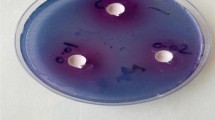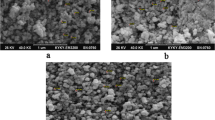Abstract
The aim of this study was to prepare zinc oxide nanoparticles from chitosan and Piper longum and to assess the antimicrobial activity. The chitosan is a biocompatible polymer and also used as a polymeric nanoparticle. P. longum is a flowering vine which is commonly used as a spice to season food. It is also being used as a traditional medicine that treats asthma, viral hepatitis, cough, and respiratory infections. Dental varnishes are usually applied on the tooth surface and are similar to fluoride varnishes that prevent tooth decay. The zinc oxide nanoparticles were prepared using the P. longum plant extract and color change was noted. The nanoparticle formation was confirmed using UV–Vis spectroscopy and the solution was centrifuged for 10 min and the nanoparticles were collected. The chitosan was prepared using 1% acetic acid with chemical reaction. In a centrifuge tube, 100 µL of prepared nanoparticles, with the addition of chemical ingredients the varnish, were prepared. The study showed Staphylococcus aureus to be very sensitive with a maximum zone of inhibition followed by Sterptococcus mutants, Enterococcus faecalis, and Candida albicans. P. longum- and chitosan-assisted nano zinc oxide–based dental varnishes will be a better choice for infections caused by S. aureus and S. mutans.




Similar content being viewed by others
Data Availability
The datasets generated and analyzed during the current study are available from the corresponding author on a reasonable request.
References
Jacob, S. J. P., Finub, J. S., & Narayanan, A. (2012). Synthesis of silver nanoparticles using Piper longum leaf extracts and its cytotoxic activity against Hep-2 cell line. Colloids and Surfaces. B, Biointerfaces, 91, 212–214.
Paulkumar, K., Gnanajobitha, G., Vanaja, M., Rajeshkumar, S., Malarkodi, C., Pandian, K., et al., (2014). Piper nigrum leaf and stem assisted green synthesis of silver nanoparticles and evaluation of its antibacterial activity against agricultural plant pathogens. ScientificWorld Journal. 2014:829894.
Jamila, N., Khan, N., Bibi, A., Haider, A., Khan, S.N., Atlas, A., et al. (2020). Piper longum catkin extract mediated synthesis of Ag, Cu, and Ni nanoparticles and their applications as biological and environmental remediation agents [Internet]. Arabian Journal of Chemistry, 13, 6425–36. Available from: https://doi.org/10.1016/j.arabjc.2020.06.001
Wei, D., Sun, W., Qian, W., Ye, Y., & Ma, X. (2009). The synthesis of chitosan-based silver nanoparticles and their antibacterial activity. Carbohydrate Research, 344(17), 2375–2382.
Khor, E. (2010). Medical applications of chitin and chitosan [Internet]. Chitin, Chitosan, Oligosaccharides and Their Derivatives. p. 405–13. Available from: https://doi.org/10.1201/ebk1439816035-c30
Bui, V., Park, D., Lee, .Y-C. (2017). Chitosan combined with ZnO, TiO2 and Ag nanoparticles for antimicrobial wound healing applications: A mini review of the research trends [Internet]. Polymers, 9, 21. Available from: https://doi.org/10.3390/polym9010021
De Luca, M.P., Franca, J.R., Macedo, F.A.F.F., Grenho, L., Cortes, M.E., Faraco, A.A.G., et al. (2014). Propolis varnish: antimicrobial properties against cariogenic bacteria, cytotoxicity, and sustained-release profile. BioMed Research International, 2014, 48647.
Franca, J.R., De Luca, M.P., Ribeiro, T.G., Castilho, R.O., Moreira, A.N., Santos, V.R., et al. (2014). Propolis - based chitosan varnish: drug delivery, controlled release and antimicrobial activity against oral pathogen bacteria [Internet]. BMC Complementary and Alternative Medicine, 14. Available from: https://doi.org/10.1186/1472-6882-14-478
Rajeshkumar, S., & Naik, P. (2018). Synthesis and biomedical applications of cerium oxide nanoparticles - A review. Biotechnology Reports (Amsterdam, Netherlands), 17, 1–5.
Rajeshkumar, S., Agarwal, H., Venkat Kumar, S., Lakshmi, T. (2018). Brassica oleracea mediated synthesis of zinc oxide nanoparticles and its antibacterial activity against pathogenic bacteria [Internet]. Asian Journal of Chemistry, 30, 2711–5. Available from: https://doi.org/10.14233/ajchem.2018.21562
Tahoora, T.L., Hannah, R., Rajeshkumar, S. (2020). Free radical scavenging activity of fruit formulation mediated zinc oxide nanoparticles [internet]. International Journal of Research in Pharmaceutical Sciences, 11, 4690–4. Available from: https://doi.org/10.26452/ijrps.v11i3.2757
Malarkodi, C., Rajeshkumar, S., Paulkumar, K., Vanaja, M., Gnanajobitha, G., Annadurai, G. (2014). Biosynthesis and antimicrobial activity of semiconductor nanoparticles against oral pathogens [Internet]. Bioinorganic Chemistry and Applications, 2014, 1–10. Available from: https://doi.org/10.1155/2014/347167
Santhoshkumar, J., Venkat Kumar, S., Rajeshkumar, S. (2017). Synthesis of zinc oxide nanoparticles using plant leaf extract against urinary tract infection pathogen [Internet]. Resource-Efficient Technologies, 3, 459–65. Available from: https://doi.org/10.1016/j.reffit.2017.05.001
Agarwal, H., Venkat Kumar, S., Rajeshkumar, S. (2017). A review on green synthesis of zinc oxide nanoparticles – An eco-friendly approach [Internet]. Resource-Efficient Technologies, 3, 406–13. Available from: https://doi.org/10.1016/j.reffit.2017.03.002
Rajeshkumar, S., Kumar, S. V., Ramaiah, A., Agarwal, H., Lakshmi, T., & Roopan, S. M. (2018). Biosynthesis of zinc oxide nanoparticles using Mangifera indica leaves and evaluation of their antioxidant and cytotoxic properties in lung cancer (A549) cells. Enyzme and Microbial Technology, 117, 91–95.
Happy, A., Soumya, M., Venkat Kumar, S., Rajeshkumar, S., David Sheba, R., Lakshmi, T., et al. (2019). Phyto-assisted synthesis of zinc oxide nanoparticles using Cassia alata and its antibacterial activity against Escherichia coli [Internet]. Biochemistry and Biophysics Reports, 17, 208–11. Available from: https://doi.org/10.1016/j.bbrep.2019.01.002
Sujatha, J., Asokan, S., Rajeshkumar, S. (2018). Antidermatophytic activity of green synthesised zinc oxide nanoparticles using cassia alata leaves [Internet]. Journal of Microbiology, Biotechnology and Food Sciences, 7, 348–52. Available from: https://doi.org/10.15414/jmbfs.2018.7.4.348-352
Acknowledgements
The authors would like to acknowledge Saveetha Dental College and Hospital, Chennai for the constant support.
Funding
Self-funding.
Author information
Authors and Affiliations
Contributions
SR designed this study, HB carried out this research.SR, HB, and AR wrote and corrected this manuscript.
Corresponding author
Ethics declarations
Competing Interests
The author declares no competing interests.
Additional information
Publisher's Note
Springer Nature remains neutral with regard to jurisdictional claims in published maps and institutional affiliations.
Rights and permissions
About this article
Cite this article
Harini, B., Rajeshkumar, S. & Roy, A. Biomedical Application of Chitosan and Piper Longum-assisted Nano Zinc Oxide–based Dental Varnish. Appl Biochem Biotechnol 194, 1303–1309 (2022). https://doi.org/10.1007/s12010-021-03712-8
Received:
Accepted:
Published:
Issue Date:
DOI: https://doi.org/10.1007/s12010-021-03712-8




